English
- Afrikaans
- Albanian
- Amharic
- Arabic
- Armenian
- Azerbaijani
- Basque
- Belarusian
- Bengali
- Bosnian
- Bulgarian
- Catalan
- Cebuano
- Corsican
- Croatian
- Czech
- Danish
- Dutch
- English
- Esperanto
- Estonian
- Finnish
- French
- Frisian
- Galician
- Georgian
- German
- Greek
- Gujarati
- Haitian Creole
- hausa
- hawaiian
- Hebrew
- Hindi
- Miao
- Hungarian
- Icelandic
- igbo
- Indonesian
- irish
- Italian
- Japanese
- Javanese
- Kannada
- kazakh
- Khmer
- Rwandese
- Korean
- Kurdish
- Kyrgyz
- Lao
- Latin
- Latvian
- Lithuanian
- Luxembourgish
- Macedonian
- Malgashi
- Malay
- Malayalam
- Maltese
- Maori
- Marathi
- Mongolian
- Myanmar
- Nepali
- Norwegian
- Norwegian
- Occitan
- Pashto
- Persian
- Polish
- Portuguese
- Punjabi
- Romanian
- Russian
- Samoan
- Scottish Gaelic
- Serbian
- Sesotho
- Shona
- Sindhi
- Sinhala
- Slovak
- Slovenian
- Somali
- Spanish
- Sundanese
- Swahili
- Swedish
- Tagalog
- Tajik
- Tamil
- Tatar
- Telugu
- Thai
- Turkish
- Turkmen
- Ukrainian
- Urdu
- Uighur
- Uzbek
- Vietnamese
- Welsh
- Bantu
- Yiddish
- Yoruba
- Zulu
Telephone: +86 13120555503
Email: frank@cypump.com
Aug . 14, 2024 18:47 Back to list
Innovative Chemical Liquid Pump Solutions for Efficient and Reliable Fluid Transfer in Industrial Applications
Understanding Chemical Liquid Pumps Principles and Applications
Chemical liquid pumps play a crucial role in various industrial processes, facilitating the safe and efficient transfer of chemicals, solvents, and other liquids. With the increasing demand for efficient chemical handling across industries such as pharmaceuticals, petrochemicals, and wastewater treatment, understanding the working principles and types of chemical liquid pumps is essential for optimizing operations.
Types of Chemical Liquid Pumps
There are several types of chemical liquid pumps, each designed for specific applications and liquid properties
. The most common types include1. Positive Displacement Pumps These pumps operate by trapping a fixed amount of liquid and forcing it into the discharge pipe. This category includes gear pumps, diaphragm pumps, and peristaltic pumps. Positive displacement pumps are ideal for pumping thick liquids or those with varying viscosities, making them popular in the chemical industry.
2. Centrifugal Pumps Utilizing rotational energy to move liquids, centrifugal pumps are the most widely used type of pump for transferring clean liquids at high flow rates. They are efficient for low-viscosity fluids and are commonly found in applications involving water, solvents, and acidic solutions. However, they can struggle with viscous or shear-sensitive materials.
3. Magnetic Drive Pumps These pumps feature a magnetic coupling that eliminates the need for mechanical seals, making them ideal for handling corrosive or hazardous chemicals. The absence of seals reduces the risk of leaks, improving safety and reliability in chemical processing.
Key Features and Considerations
When selecting a chemical liquid pump, several factors must be considered
chemical liquid pump

- Chemical Compatibility Understanding the chemical properties of the liquids being pumped is crucial. The pump materials must be resistant to corrosion and degradation to ensure longevity and safety. Common materials include stainless steel, PTFE, and polypropylene.
- Viscosity and Flow Rate The viscosity of the liquid impacts the pump choice. Higher viscosity liquids often require positive displacement pumps, while lower viscosity fluids can be efficiently managed by centrifugal pumps. Additionally, the required flow rate should be determined to select a pump that meets the operational demand.
- Operating Environment The operational conditions, such as temperature, pressure, and explosiveness of the chemicals, must be evaluated. Some applications may require specialized pumps that can handle high-pressure scenarios or extreme temperatures.
- Maintenance and Reliability Reliability is essential in chemical pumping. Regular maintenance schedules should be established to prevent equipment failure. Selecting pumps with fewer moving parts can also enhance reliability.
Applications of Chemical Liquid Pumps
Chemical liquid pumps are employed across numerous sectors. In the pharmaceutical industry, they are used to precisely dispense active ingredients, ensuring consistent formulations. In petrochemical applications, they transport crude oil and refined products through complex pipelines. Environmental engineering also relies on chemical pumps for wastewater treatment, where they help in transferring chemicals for flocculation, disinfection, and pH adjustment.
Conclusion
Chemical liquid pumps are indispensable tools in the successful operation of various industries dealing with the transport and processing of liquids. By understanding the types, features, and applications of these pumps, businesses can make informed decisions that enhance productivity, safety, and efficiency. As technology continues to evolve, innovations in pump design and materials will likely drive further advancements in the capabilities of chemical liquid pumps, ensuring they meet the growing demands of modern industrial processes.
-
ISG Series Vertical Pipeline Pump - Chi Yuan Pumps Co., LTD.|Advanced Hydraulic Design&Energy-Efficient Solutions
NewsJul.30,2025
-
ISG Series Vertical Pipeline Pump - Chi Yuan Pumps Co., LTD.
NewsJul.30,2025
-
ISG Series Vertical Pipeline Pump - Chi Yuan Pumps Co., LTD.|energy-efficient fluid handling&industrial durability
NewsJul.30,2025
-
ISG Series Vertical Pipeline Pump - Chi Yuan Pumps | Advanced Engineering&Industrial Efficiency
NewsJul.30,2025
-
ISG Series Pipeline Pump - Chi Yuan Pumps | High Efficiency, Energy Saving
NewsJul.30,2025
-
ISG Series Vertical Pipeline Pump-Chi Yuan Pumps|High Efficiency&Reliable Performance
NewsJul.29,2025










